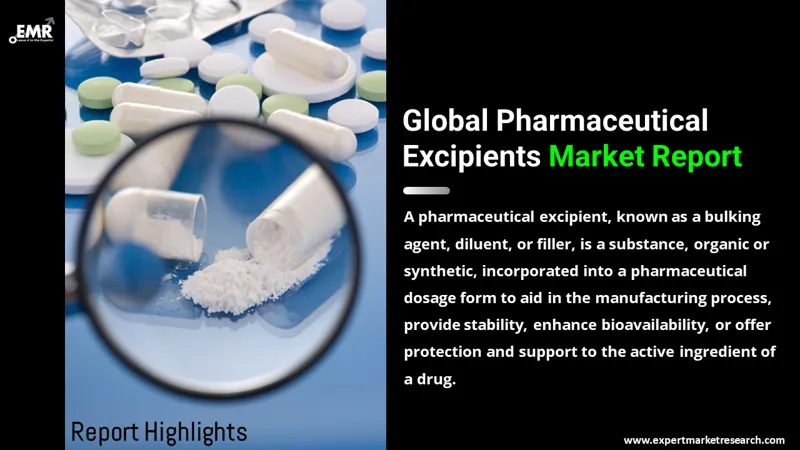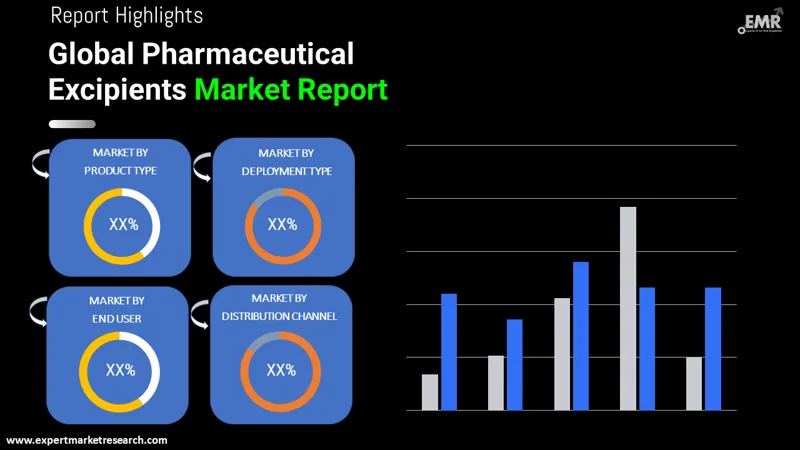
Consumer Insights
Uncover trends and behaviors shaping consumer choices today
Procurement Insights
Optimize your sourcing strategy with key market data
Industry Stats
Stay ahead with the latest trends and market analysis.
The pharmaceutical excipients market was valued at USD 12.25 Billion in 2025, driven by the growing demand for biopharmaceuticals and advancements in drug formulation technologies across the globe. The market is anticipated to grow at a CAGR of 6.50% during the forecast period of 2026-2035, with the values likely to reach USD 22.99 Billion by 2035.
Base Year
Historical Period
Forecast Period
Compound Annual Growth Rate
6.5%
Value in USD Billion
2026-2035
*this image is indicative*
A pharmaceutical excipient, also referred to as a bulking agent, diluent, or filler, is an organic or synthetic product formulated with the active ingredient of a drug, included in a pharmaceutical dosage form to assist in the manufacturing process to protect, support, or enhance stability, or for bioavailability. They also help to identify products and improve general product safety or functionality during storage or use.

Read more about this report - REQUEST FREE SAMPLE COPY IN PDF
The EMR’s report titled “Pharmaceutical Excipients Market Report and Forecast 2026-2035” offers a detailed analysis of the market based on the following segments:
Market Breakup by Product Type
Market Breakup by Functionality
Market Breakup by End User
Market Breakup by Distribution Channel
Market Breakup by Region

Read more about this report - REQUEST FREE SAMPLE COPY IN PDF
The pharmaceutical excipients market is driven by factors such as the growing pharmaceutical industry combined with advances in functional excipients, increased use of orphan drugs, and the increased use of biopharmaceuticals. The advent of multifunctional excipients, the shifting focus of pharmaceutical manufacturing to emerging markets, and the increasing biosimilar sector also pose important growth possibilities in the pharmaceutical excipients market for the market players.
The report presents a detailed analysis of the following key players in the global pharmaceutical excipients market, looking into their capacity, market shares, and latest developments like capacity expansions, plant turnarounds, and mergers and acquisitions:
The EMR report gives an in-depth insight into the industry by providing a SWOT analysis as well as an analysis of Porter’s Five Forces model.




*While we strive to always give you current and accurate information, the numbers depicted on the website are indicative and may differ from the actual numbers in the main report. At Expert Market Research, we aim to bring you the latest insights and trends in the market. Using our analyses and forecasts, stakeholders can understand the market dynamics, navigate challenges, and capitalize on opportunities to make data-driven strategic decisions.*
Get in touch with us for a customized solution tailored to your unique requirements and save upto 35%!
The market was valued at USD 12.25 Billion in 2025.
The market is anticipated to grow at a CAGR of 6.50% during the forecast period of 2026-2035, with the values likely to reach USD 22.99 Billion by 2035.
The major drivers expected to aid the market growth are the growth of the pharmaceutical sector, rising demand for OTC drugs, advancements in biotechnology, and the development of the multifunctional excipients.
The key market trends guiding the growth of the pharmaceutical excipients market include growing technological advancements, and the launch of new products owing to increased research and development activities.
The major regions in the market are North America, Latin America, the Middle East and Africa, Europe, and the Asia Pacific.
Organic chemicals and inorganic chemicals, among others, are the leading pharmaceutical excipients products in the market.
Oral formulations, topical formulations, and parenteral formulations, among others, are the major formulations of the product in the market.
The significant functionalities of the product in the market include fillers and diluents, suspending and viscosity agents, coating agents, binders, flavouring agents and sweeteners, disintegrants, colourants, lubricants and glidants, preservatives, and emulsifying agents, among others.
The major players in the global pharmaceutical excipients market are DuPont De Nemours, Inc., Roquette Frères, Ashland Global Holdings Inc., Evonik Industries AG, BASF SE, Kerry Group PLC, Croda International Plc, ABF Ingredients Limited, Archer Daniels Midland Company, The Lubrizol Corporation, Innophos Holdings Inc., and WACKER Chemie AG, among others.
Explore our key highlights of the report and gain a concise overview of key findings, trends, and actionable insights that will empower your strategic decisions.
| REPORT FEATURES | DETAILS |
| Base Year | 2025 |
| Historical Period | 2019-2025 |
| Forecast Period | 2026-2035 |
| Scope of the Report |
Historical and Forecast Trends, Industry Drivers and Constraints, Historical and Forecast Market Analysis by Segment:
|
| Breakup by Product Type |
|
| Breakup by Functionality |
|
| Breakup by End User |
|
| Breakup by Distribution Channel |
|
| Breakup by Region |
|
| Market Dynamics |
|
| Supplier Landscape |
|
| Companies Covered |
|
| Report Price and Purchase Option | Explore our purchase options that are best suited to your resources and industry needs. |
| Delivery Format | Delivered as an attached PDF and Excel through email, with an option of receiving an editable PPT, according to the purchase option. |
Single User License
One User
USD 5,499
USD 4,949
tax inclusive*
Datasheet
One User
USD 3,299
USD 2,969
tax inclusive*
Five User License
Five User
USD 6,999
USD 5,949
tax inclusive*
Corporate License
Unlimited Users
USD 8,199
USD 6,969
tax inclusive*
*Please note that the prices mentioned below are starting prices for each bundle type. Kindly contact our team for further details.*
Flash Bundle
Small Business Bundle
Growth Bundle
Enterprise Bundle
*Please note that the prices mentioned below are starting prices for each bundle type. Kindly contact our team for further details.*
Flash Bundle
Number of Reports: 3
20%
tax inclusive*
Small Business Bundle
Number of Reports: 5
25%
tax inclusive*
Growth Bundle
Number of Reports: 8
30%
tax inclusive*
Enterprise Bundle
Number of Reports: 10
35%
tax inclusive*
How To Order

Select License Type
Choose the right license for your needs and access rights.

Click on ‘Buy Now’
Add the report to your cart with one click and proceed to register.

Select Mode of Payment
Choose a payment option for a secure checkout. You will be redirected accordingly.
Gain insights to stay ahead and seize opportunities.

Get insights & trends for a competitive edge.

Track prices with detailed trend reports.

Analyse trade data for supply chain insights.

Leverage cost reports for smart savings

Enhance supply chain with partnerships.

Connect For More Information
Our expert team of analysts will offer full support and resolve any queries regarding the report, before and after the purchase.
Our expert team of analysts will offer full support and resolve any queries regarding the report, before and after the purchase.
We employ meticulous research methods, blending advanced analytics and expert insights to deliver accurate, actionable industry intelligence, staying ahead of competitors.
Our skilled analysts offer unparalleled competitive advantage with detailed insights on current and emerging markets, ensuring your strategic edge.
We offer an in-depth yet simplified presentation of industry insights and analysis to meet your specific requirements effectively.
Share